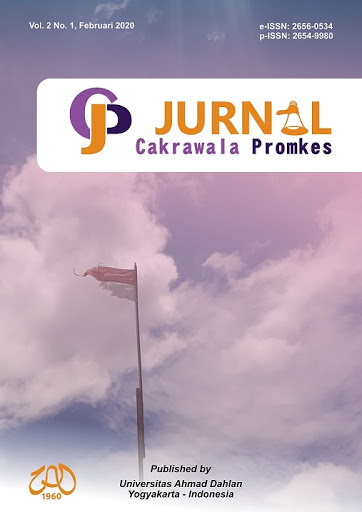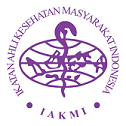Narrative review: pengaruh terapi massage counterpressure terhadap pengurangan nyeri dalam persalinan
DOI:
https://doi.org/10.12928/promkes.v3i2.4573Keywords:
Narative review, Massage, Counterpressure, Labor painAbstract
Labor often prompts unpleasant, fearful, or, further, traumatic
experiences due to the pain it entails. Scientific evidence suggests that
pain during labor can be managed using two methods; pharmacological
and non-pharmacological. Pharmacology is a method of using drugs,
whereas non-pharmacologic is without the administration of drugs. The nonpharmacological
method is known as complementary and alternative
therapies, one practice is through massage. Massage frequently
performed to reduce labor pain is counterpressure. The purpose of this
study is to investigate the effect of counterpressure massage therapy as
a measure to reduce labor pain. The method used is a narrative review.
Article exploration was carried out in several databases, which are
Pubmed and Science Direct. In the case of Gray Literature, it was
accessed via Google Scholar. Specific keywords were employed for
literature search and articles were selected by considering inclusion and
exclusion criteria. The article selection process was elaborated
transparently in the PRISMA Flowchart. From the article selection
procedure, 14 articles were identified and fulfilled the criteria. Thus,
articles were critically analyzed (Critical Appraisal) using the Mixed
Method Appraisal Tool (MMAT). The review concludes that
counterpressure is a massage performed by applying continuous
pressure to the patient's sacral with the heel of the hand or fist of the
hand. Counterpressure massage can be done in a straight stroke or small
circular stroke. This technique is proven to be sufficient in relieving back
pain during labor. The recommendation suggested is based on the 14
articles reviews carried out that a common problem occurring in laboring
women is physiological pain experience during childbirth so that it may
provoke bad experiences for mothers, especially fear and anxiety that
may lead to prolonged labor.
References
(2)Vaira, R., Yanti, & Hidayat, A. (2020). A qualitative study of partnership between woman and midwife within midwife-led care clinic | Vaira | Journal of Health Technology Assessment inMidwifery.https://ejournal.unisayogya.ac.id/ejournal/index.php/JHTAM/article/view/1368/pdf
(3)Farida, S., & Sulistiyanti, A. (2019). Metode Counterpressure Sebagai Upaya Untuk Mengurangi Nyeri Persalinan Kala I. Smiknas, 217–222.
(4)Fitri, N., Nadia Emilda, D., Kesehatan, F., Fort De Kock, U., & Barat Indonesia, S. (2020). Perbandingan Massage Counterpressure Dan Massage Counter Pressure Menggunakan Minyak Esensial Lavender Terhadap Tingkat Nyeri Persalinan Kala I Fase Aktif. Maternal Child Health Care Journal, 2(3).
(5)Gonenc, I. M., & Terzioǧlu, F. (2020). Effects of massage and acupressure on relieving labor pain, reducing labor time, and increasing delivery satisfaction. Journal of Nursing Research, 28(1), 1–9. https://doi.org/10.1097/jnr.0000000000000344
(6)Karuniawati, B. (2019). Efektivitas Massage Counter Dalam Menurunkan Intensitas Nyeri Persalinan Kala I. Jurnal Kesehatan Madani Medika, 10(2), 69–75. https://doi.org/10.36569/jmm.v10i2.63
(7)Mafetoni, R. R., & Shimo, A. K. K. (2016). Efeitos da acupressão sobre a dor no trabalho de parto: Ensaio clÃnico randomizado. Revista Latino-Americana de Enfermagem, 24. https://doi.org/10.1590/1518-8345.0739.2738
(8)Oka, I. (2017). PENGARUH PEMBERIAN TEKNIK COUNTERPRESSURE TERHADAP PENURUNAN INTENSITAS NYERI PADA KALA I PERSALINAN. 07(09), 91–96.
(9)Rilyani, Arianti, L., & Wiagi. (2017). Pengaruh Counter Pressure Terhadap Skala Nyeri Persalinan Di Rumah. Jurnal Kesehatan Holistik, 11(4), 257–264.
(10)Satria, M. (2018). Pengaruh Sebelum Dan Sesudah Dilakukan Pijat Punggung Teknik Conterpressure Terhadap Pengurangan Rasa Nyeri Ibu Bersalin Kala I Fase Aktif Di klinik bidan elviana. Menara Ilmu, XII(5), 85–92.
(11)Torkiyan, H., Sedigh Mobarakabadi, S., Heshmat, R., Khajavi, A., & Ozgoli, G. (2021). The effect of GB21 acupressure on pain intensity in the first stage of labor in primiparous women: A randomized controlled trial. Complementary Therapies in Medicine, 58, 102683. https://doi.org/10.1016/j.ctim.2021.102683
(12)Yulianingsih, E., Surya, H., & Suwarni, P. (2019). Teknik Massage Counterpressure terhadap Penurunan Intensitas Nyeri Kala l Fase Aktif pada Ibu Bersalin di RSUD. Dr. M. M Dunda Limboto. 17(2), 231–242.
(13)Hong, Q., Pluye, P., Fà bregues, S., Bartlett, G., Boardman, F., Cargo, M., Dagenais, P., Gagnon, M.-P., Griffiths, F., Nicolau, B., Rousseau, M.-C., &Vedel, I. (2018). Mixed Methods Appraisal Tool (MMAT), Version 2018. User guide. McGill, 1–11.
(14)Darmayanti, &Suhrawardi. (2019). Counter Pressure EfektifMengurangi Nyeri Persalinan( Effectively of Counterpressure Reduce Labor Pain ). Caring Nursing Journal, 3(1), 1–6. https://journal.umbjm.ac.id/index.php/caring-nursing
(15)Fitri, N., Nadia Emilda, D., Kesehatan, F., Fort De Kock, U., & Barat Indonesia, S. (2020). Perbandingan Massage Counterpressure Dan Massage Counter Pressure MenggunakanMinyakEsensial Lavender Terhadap Tingkat Nyeri Persalinan Kala I FaseAktif. Maternal Child Health Care Journal, 2(3).
(16)Rilyani, Arianti, L., &Wiagi. (2017). Pengaruh Counter Pressure Terhadap Skala Nyeri Persalinan Di Rumah. JurnalKesehatanHolistik, 11(4), 257–264.
(17)Yulianingsih, E., Surya, H., &Suwarni, P. (2019). Teknik Massage Counterpressure terhadapPenurunanIntensitas Nyeri Kala l FaseAktif
(18)Oka, I. (2017). PENGARUH PEMBERIAN TEKNIK COUNTERPRESSURE TERHADAP PENURUNAN INTENSITAS NYERI PADA KALA I PERSALINAN. 07(09), 91–96.
(19) Farida, S., &Sulistiyanti, A. (2019). Metode Counterpressure SebagaiUpayaUntukMengurangi Nyeri Persalinan Kala I. Smiknas, 217–222.
(20)Budiarti, A. (2020). Pengaruh Terapi Massage Counterpressure Terhadap Nyeri Kala I Pada Ibu Inpartu Di BPS Desa Durjan, Bangkalan. Jurnal Ilmu Keperawatan Maternitas, 3(1), 14. https://doi.org/10.32584/jikm.v3i1.79
(21)Fitiawati, L. (2020). Perbedaan Tingkat Nyeri Persalinan Sebelum dan Sesudah Terapi Acupressure Poit for Lacatation pada Ibu Bersalin Kala I di Rumah Sakit Jember Klinik Kabupaten Jember. Skripsi.
(22)Irawan, D. (2020). Pengaruh Counter Pressure Terhadap Penurunan Nyeri Persalinan Kala I Sytematic Review. 2507(February), 1–9.
(23)Salakory, J. A. (2018). Perbedaan Teknik Back Deep Massage Dan Firm Counter Pressure Terhadap Nyeri Ibu Inpartu Kala I Fase Aktif Di Kamar Bersalin Rumah Sakit Umum Daerah Dr. M. Haulussy Ambon. Global Health Science, 3(4), 339–345.
(24)Torkiyan, H., SedighMobarakabadi, S., Heshmat, R., Khajavi, A., &Ozgoli, G. (2021). The effect of GB21 acupressure on pain intensity in the first stage of labor in primiparous women: A randomized controlled trial. Complementary Therapies in Medicine, 58, 102683. https://doi.org/10.1016/j.ctim.2021.102683
(25)Karuniawati, B. (2019). Efektivitas Massage Counter DalamMenurunkanIntensitas Nyeri Persalinan Kala I. JurnalKesehatanMadaniMedika, 10(2), 69–75. https://doi.org/10.36569/jmm.v10i2.63
(26)Satria, M. (2018). PengaruhSebelum Dan SesudahDilakukanPijatPunggung Teknik ConterpressureTerhadapPengurangan Rasa Nyeri IbuBersalin Kala I FaseAktif Di klinikbidanelviana. Menara Ilmu, XII(5), 85–9217. Gönenç, I. M., &Terzioǧlu, F. (2020). Effects of massage and acupressure on relieving labor pain, reducing labor time, and increasing delivery satisfaction. Journal of Nursing Research, 28(1), 1–9. https://doi.org/10.1097/jnr.0000000000000344
(27)Mafetoni, R. R., &Shimo, A. K. K. (2016). Efeitos da acupressãosobre a dor no trabalho de parto: ensaioclÃnicorandomizado. Revista Latino-Americana de Enfermagem, 24. https://doi.org/10.1590/1518-8345.0739.2738.
(28)Gonenc, I. M., &Terzioglu, F. (2020). Effects of massage and acupressure on relieving labor pain, reducing labor time, and increasing delivery satisfaction. Journal of Nursing Research, 28(1), 1–9. https://doi.org/10.1097/jnr.0000000000000344
Downloads
Published
Issue
Section
License
Copyright (c) 2021 Hutari Puji Astuti

This work is licensed under a Creative Commons Attribution-ShareAlike 4.0 International License.
Authors who publish with JCP: Jurnal Cakrawala Promkes agree to the following terms:
- Authors retain copyright and grant the journal the right of first publication with the work simultaneously licensed under a Creative Commons Attribution License (CC BY-SA 4.0) that allows others to share the work with an acknowledgement of the work's authorship and initial publication in this journal.
- Authors are able to enter into separate, additional contractual arrangements for the non-exclusive distribution of the journal's published version of the work (e.g., post it to an institutional repository or publish it in a book), with an acknowledgement of its initial publication in this journal.
- Authors are permitted and encouraged to post their work online (e.g., in institutional repositories or on their website) prior to and during the submission process, as it can lead to productive exchanges, as well as earlier and greater citation of published work.

This work is licensed under a Creative Commons Attribution-ShareAlike 4.0 International License












